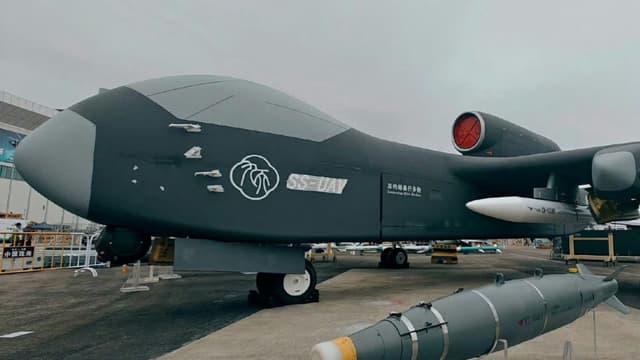| IN A NUTSHELL |
|
In a move that seems straight out of a science fiction novel, China’s People’s Liberation Army (PLA) is set to launch the Jiu Tian, a colossal drone mothership. This marvel of engineering, literally translating to “High Sky,” is poised to redefine military power dynamics not only in the air but on a global scale. As the largest drone carrier ever built, the Jiu Tian underscores China’s commitment to advancing unmanned military technologies, potentially surpassing U.S. capabilities. As geopolitical tensions rise, particularly in strategic areas like the South China Sea and the Taiwan Strait, this development is one to watch closely.
The Silent Yet Formidable Giant
The Jiu Tian is a next-generation Unmanned Aerial Vehicle (UAV), designed to fly at high altitudes and cover vast distances. Its impressive features include a range of 4,350 miles and a ceiling of 49,000 feet, with a takeoff weight of 35,274 pounds. This means it can operate above most conventional air defense systems without detection. The combination of its altitude and extensive range allows the drone to conduct reconnaissance or offensive missions in remote areas while remaining out of reach of standard surface-to-air missiles.
Thanks to its high altitude and great autonomy, the Jiu Tian can remain on mission for extended periods, ranging from several hours to potentially several days. This endurance, paired with its technological sophistication, gives it a strategic edge in modern warfare scenarios. The ability to fly undetected over hostile territories could significantly alter the course of military engagements, offering a new level of operational efficiency and effectiveness.
Carrying Up to 100 Miniature Drones
What truly sets the Jiu Tian apart is its role as a “flying mothership.” It has the capacity to carry and deploy up to 100 miniature drones or loitering munitions, some designed for kamikaze attacks. These small drones are stored in two internal bays and can be released in swarms, executing coordinated and overwhelming attacks against enemy defenses.
This tactic, known as swarm warfare, leverages the strength of numbers and the autonomy of drones to overwhelm or deceive defense systems. It’s a concept already tested by U.S. forces and now taken to new heights by China. By deploying these drones in swarms, the Jiu Tian enhances its offensive capabilities, creating a formidable challenge for traditional military systems.
A Multi-Mission Platform
Beyond its offensive capabilities, the Jiu Tian is a flexible platform capable of fulfilling multiple roles. Its modular architecture allows for equipment adaptation to various missions, including intelligence gathering, surveillance, electronic warfare, and even emergency rescue operations.
This versatility opens up numerous possibilities, such as maritime surveillance for securing shipping lanes, border protection, or rapid disaster management. The dual civic and military purpose is a major strategic feature of new Chinese technologies, designed for quick and effective deployment in diverse contexts. This adaptability not only enhances military prowess but also strengthens China’s position in civil operations.
| Feature | Specification |
|---|---|
| Range | 4,350 miles |
| Ceiling | 49,000 feet |
| Takeoff Weight | 35,274 pounds |
| Drone Capacity | Up to 100 mini drones |
A Direct Response to American Drones?
The Jiu Tian is part of an already impressive Chinese fleet, including the stealthy CH-7 drones and the Wing Loong-X specialized in anti-submarine warfare. In response, the United States continues to deploy systems like the MQ-9 Reaper, which is agile but limited in size, or the RQ-4 Global Hawk, highly effective at altitude but lacking offensive capabilities.
With the Jiu Tian, China clearly demonstrates its ambition to become a drone superpower, especially in sensitive areas where airspace control is a key issue. As these technologies evolve, the balance of power in military engagements could shift significantly, with China positioning itself as a formidable competitor to Western drone capabilities.
What This Really Changes
The advent of advanced drones like the Jiu Tian could transform the very nature of military conflicts. By reducing the need for direct human intervention, these technologies expand the scope and speed of operations, allowing for more discreet and complex strategies.
Although the project is still in the testing phase, its potential is immense, promising to revolutionize modern warfare by adding a new dimension to confrontations where technological mastery becomes the decisive factor. Even though its name suggests celestial heights, it is at ground level, through its swarming drones, that the Jiu Tian might one day determine the outcome of a conflict.
As the global landscape of military technology evolves, the Jiu Tian stands as a testament to China’s rapid advancements in drone innovation. How will this influence the future of military strategy and international relations? Only time will tell.
Did you like it? 4.5/5 (29)









Wow, 100 mini drones at once? That’s like a swarm of bees on a military mission! 🐝
Why is China focusing so much on drone technology? Are they trying to start a tech race?
Does this mean traditional air defense systems are becoming obsolete?
Impressive range and ceiling! But what about the stealth capabilities of the Jiu Tian?
Sounds like something out of a sci-fi movie. Will we see it in action soon? 🎥